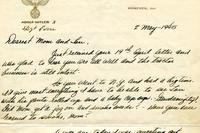COLORADO SPRINGS, Colo. -- An entrepreneurial collaboration between the Air Force Academy and Penrose-St. Francis Health Services is creating a device to help patients recover their full range of motion after suffering a stroke or injury.
The project - called Neumimic - is the result of a partnership between mechanical and electrical engineering cadets here and Dr. Glen House, head of Penrose's rehabilitation department.
Cadets designed a brace that holds a patient's arm in such a way the patient must move it exactly according to directions from a physical therapist. At the same time, patients are connected to Microsoft Kinect, which records their progress even when therapists aren't in the room.
The project started in 2012, and cadets are scheduled to put the finishing touches on it next fall. It's now being used in Penrose's rehab center and Walter Reed Army Medical Center has expressed interest in trying it out for patients in its Wounded Warrior program.
FalconWorks, a nonprofit that manages the tech-transfer aspects of many of the Academy's research projects, asked House for help.
What product would help him do his job that currently doesn't exist in today's healthcare market, House wondered?
"So I told them, 'I need a way for patients to exercise without a physical therapist, but still do the motions correctly,'" House said. "And I told them that if they wanted to sell it, they had to keep the costs low, or no one would buy it."
The result is the Neumimic. House said he's seen great results from using it with his stroke patients because they continue to exercise - and exercise correctly - even when a therapist isn't available.
"It works - it's not expensive, and we've seen just great results from it," he said. "It turns half an hour of work with the therapist into hour's worth of results. It flipped the process - people can exercise first and the physical therapist can check on them. We can set goals and come back and see what's been gained."
House said the brain recovers from strokes through repetition - doing the same exercises over and over, exactly the same way. But when patients are left to their own devices, they won't do the exercise exactly as prescribed; they tend to take shortcuts that make the movement easier. That doesn't aid recovery from stroke or injuries, he said.
"The Neumimic fixes that," House said. "The complex brace allows the therapist to lock in the arm, so they have to accomplish the movement the exact way it's required for progress."
From cadets' perspective, the process involved working as a team to come up with a solution to a problem. But they gained more than that, said Capt. Todd Branchflower, an Academy electrical engineering instructor and one of the faculty members overseeing research on the project.
"Typically, the way a capstone project works is that cadets spend one semester designing it and the second semester implementing that design," he said. "With this project, they're finished with the design. Next semester, they're going to work on marketing the product."
The team that created the Neumimic was multi-disciplinary as well - with computer engineering, electrical engineering, mechanical engineering and some management majors all working on the project.
"People approached the problem from different areas," Branchflower said. "That's part of what's exciting about this project - the different perspectives and the chance to create a product from a need, allowed us to move very quickly."
Cadets met weekly with House at Penrose to test and further refine the design.
"We're moving as quickly as a typical startup," he said. "And that's the business model we're developing. We have a usable, marketable product. Now, we're going to work on getting it in as many hands as possible. We're going to get the feedback, and then see what we can do from there."
The experience is one cadets can use later in their Air Force careers.
"They received real-life experience," House said. "They got to see real patients, learned to work as a team, to solve the problem. And the experience has been awesome for me. They're very, very bright, very, very disciplined. You give them a challenge and they come up with a solution. Just having that caliber of people in a room means that there will be results."
FalconWorks has applied for several patents for the Neumimic which are still pending, House said. Cadets who helped invent the device will be listed on the patent.
The next step is to fine-tune the device and license it to a company - which is how FalconWorks earns money to aid in the tech-transfer process.
"We're just looking for the right partner," said House, who also serves on the board of directors for FalconWorks. "We've already talked to some companies who love the idea. And they love that it isn't expensive. It would have cost a lot more money to get two years of research and development from engineers at a company. But the cadets created this from scratch and at a low cost. It's impressive."
Capt. Ryan Silva, another Academy electrical engineering instructor, is also assisting cadets with the project.
"It's more the way business startups approach a problem - by finding a need and filling it," he said. It's allowed the cadets to come up with a solution much more quickly."


























